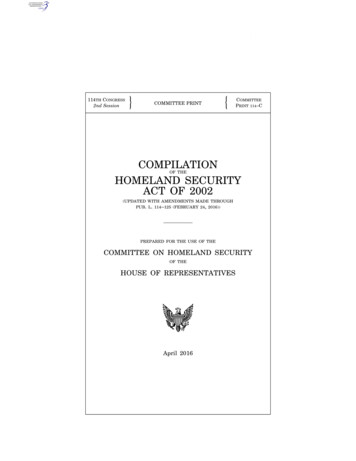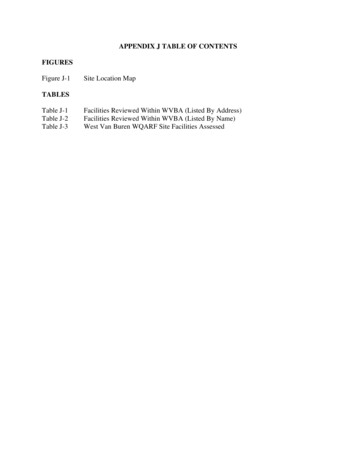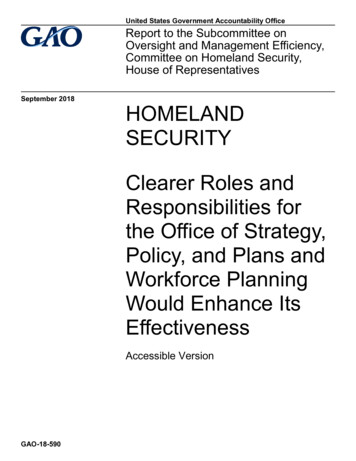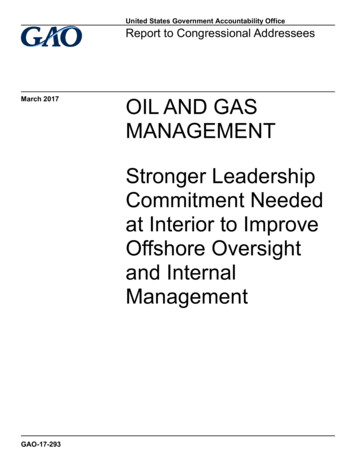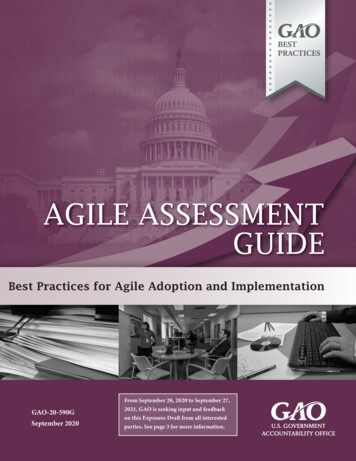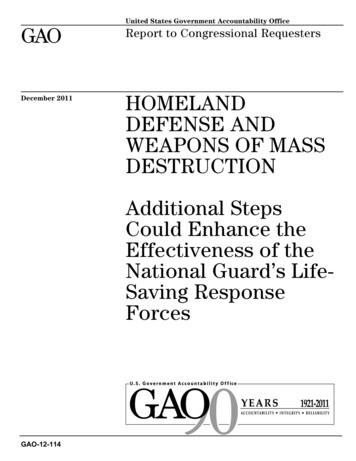
Transcription
GAODecember 2011United States Government Accountability OfficeReport to Congressional RequestersHOMELANDDEFENSE ANDWEAPONS OF MASSDESTRUCTIONAdditional StepsCould Enhance theEffectiveness of theNational Guard’s LifeSaving ResponseForcesGAO-12-114
December 2011HOMELAND DEFENSE AND WEAPONS OF MASSDESTRUCTIONHighlights of GAO-12-114, a report tocongressional requestersAdditional Steps Could Enhance the Effectiveness ofthe National Guard's Life-Saving Response ForcesWhy GAO Did This StudyWhat GAO FoundThe 2010 National Security Strategyemphasizes the importance ofstrengthening our security andresilience at home and buildingcapability to respond to and recoverfrom major chemical, biological,radiological, nuclear, and high-yieldexplosive (CBRNE) incidents. TheNational Guard has established 17CBRNE Enhanced Response ForcePackages (CERFP), which are staffedwith National Guard part-timepersonnel, to provide life-savingcapabilities in response to a CBRNEevent. The teams are intended tocoordinate operations with multipleresponse partners at the local, state,and federal levels—includingDepartment of Defense (DOD) forces.The National Guard Bureau (NGB) isresponsible for managing the CERFPprogram. GAO assessed (1) how wellCERFPs are prepared to perform theirmission and how such readiness ismeasured and reported; (2) howeffectively CERFPs coordinate withincident response partners and howwell this is evaluated; and (3) theeffectiveness of the CERFPs’command and control framework. GAOreviewed program documentation,surveyed National Guard andemergency management officials from27 states, observed training exercises,and interviewed DOD, NGB, andCERFP officials.The National Guard’s CERFPs face personnel, training, and equipmentchallenges that have adversely affected their preparedness to effectively executethe CBRNE mission. For example, state National Guard and CERFP officialscited ongoing difficulty in maintaining adequate numbers of personnel with theproficiency needed to execute many specialized tasks they are to perform, andstated that additional equipment may be needed to perform the mission. Thesechallenges highlight that NGB has not established a process to comprehensivelyreview and validate personnel, training, and equipment requirements. In addition,CERFPs’ readiness information is not comprehensively available to potentialDOD response partners because such information is not yet included in DOD’scentralized readiness-reporting system, and final plans to do so have not yetbeen developed. In the absence of accurate requirements and comprehensivereadiness information, NGB is unable to effectively prioritize funding and mitigateresource deficiencies that could jeopardize the CERFPs’ preparedness levels.What GAO RecommendsGAO recommends that DOD take anumber of actions to increase CERFPpreparedness, strengthen pre-incidentcoordination with potential responsepartners, and ensure the effectivecommand and control of operationsinvolving CERFPs. DOD agreed withthe recommendations.View GAO-12-114 or key components.For more information, contact Janet St.Laurent at (202) 512-4300 orstlaurentj@gao.gov.CERFPs coordinate with some of their potential response partners—such aslocal and state organizations—through activities such as briefings but haveachieved varying levels of success in educating such partners about CERFPcapabilities because of insufficient guidance on how to conduct interagencycoordination. Existing coordination guidance is imprecise on the frequency andtargeting of coordination activities, thereby providing little direction for prioritizingresponsibilities. Additionally, opportunities exist to enhance regional coordinationthrough interstate agreements and planning. Such agreements would allow moreeffective pooling and sharing of resources across state boundaries; however, fewinterstate agreements exist between states with and without CERFPs. NGB istaking steps to assess the CERFPs’ performance of coordination activities, butNGB’s evaluation tool, based on existing guidance, does not have coordinationstandards against which CERFP performance can be measured. In the absenceof sufficient interagency coordination guidance and evaluation standards, NGB isunable to foster a consistent approach to coordination that improves theCERFPs’ ability to respond to regional events.NGB has a framework in place for the operational command and control ofCERFPs that outlines how teams will integrate with civilian and military commandstructures. However, the command and control of operations involving CERFPsmay be limited because of (1) inadequate communications equipment; (2) theabsence of required agreements between some CERFPs and their out-of-stateelements; and (3) infrequent opportunities to practice potential command andcontrol arrangements in a realistic response environment. For example, theCERFPs’ authorized communications equipment is not interoperable with theequipment used by some other response organizations, such as first responders,and has a limited range. In addition, NGB has initiated plans to introduce 10 newforces—called Homeland Response Forces—to assist civil authorities inresponding to disasters of all kinds. This plan will affect the existing commandand control framework, but NGB has not issued updated command and controlguidance to the CERFPs. As a result of these factors, NGB lacks assurance thatCERFP operations can be commanded and controlled effectively.United States Government Accountability Office
ContentsLetter1BackgroundCERFPs Face Personnel, Training, and Equipment RequirementsChallenges, and Readiness Is Not Comprehensively ReportedOpportunities Exist to Enhance Coordination with Other ResponseOrganizationsA Command and Control Framework Is in Place, but SeveralFactors May Inhibit CERFPs’ Operational EffectivenessConclusionsRecommendations for Executive ActionAgency Comments and Our Evaluation5122838495152Appendix IScope and Methodology56Appendix IICERFP Interagency Training, 2008-201060Appendix IIIComments from the Department of Defense64Appendix IVGAO Contact and Staff Acknowledgments68Related GAO Products69TablesTable 1: Number of CERFPs with Authorized Levels of PersonnelAvailable to Perform Mission Tasks All of the Time, asReported by State Adjutants GeneralTable 2: Number of CERFPs That Had Authorized Quantities ofEquipment as of October 201015Figure 1: States That Have CERFPs within the 10 FEMA Regions722FiguresPage iGAO-12-114 Homeland Defense and Weapon of Mass Destruction
Figure 2: Approximate Time Frames within Which Some DODCBRNE Consequence Management Forces Are Expectedto Deploy after an IncidentFigure 3: CERFPs Are Formed from the State’s National GuardFigure 4: States That Will Host CERFPs and Homeland ResponseForces by September 2012Figure 5: Adjutants General Responses on CERFP Interaction withLocal, State, Regional, and Federal ResponseOrganizationsFigure 6: Command and Control Structure for State Active Dutyand Title 32 CERFP Response OperationsFigure 7: Potential CERFP Incident Site Response Partners andCommunications PathwaysFigure 8: CERFP Joint Field Training with Select PotentialResponse Partners, 2008-2010Figure 9: CERFP Joint Field Training with Emergency ManagementAgencies from States with CERFPs, 2008-2010Figure 10: CERFP Joint Field Training with EmergencyManagement Agencies from States without CERFPs, 20082010Figure 11: CERFP Joint Field Training with State National Guardsfrom States without CERFPs, CERFPCSTDCRFDODDRRSEMACFEMAHRFNGBchemical, biological, radiological, nuclear, and high-yieldexplosiveCBRNE Consequence Management Response ForceCBRNE Enhanced Response Force PackageCivil Support TeamDefense CBRN Response ForceDepartment of DefenseDefense Readiness Reporting SystemEmergency Management Assistance CompactFederal Emergency Management AgencyHomeland Response ForceNational Guard BureauThis is a work of the U.S. government and is not subject to copyright protection in theUnited States. The published product may be reproduced and distributed in its entiretywithout further permission from GAO. However, because this work may containcopyrighted images or other material, permission from the copyright holder may benecessary if you wish to reproduce this material separately.Page iiGAO-12-114 Homeland Defense and Weapon of Mass Destruction
United States Government Accountability OfficeWashington, DC 20548December 7, 2011Congressional RequestersThe potential use of weapons of mass destruction—characterized by theDepartment of Defense (DOD) as chemical, biological, radiological,nuclear, and high-yield explosive (CBRNE) material—presents acontinuing threat to the United States and its citizens. The 2010 NationalSecurity Strategy emphasizes the importance of strengthening oursecurity and resilience at home and building our capability to respond toand recover from major CBRNE incidents. 1A catastrophic CBRNE incident in the United States would require aunified national response involving entities at the local, state, and federallevels. Responding to a major CBRNE incident would include suchresponse partners as local and state police and fire departments, stateNational Guard forces, and federal agencies—including the FederalEmergency Management Agency (FEMA) and possibly federal militaryforces, such as the U.S. Marine Corps’s Chemical Biological IncidentResponse Force.The National Guard provides governors with a wide array of capabilitiesto assist in mitigating the consequences of a CBRNE incident—referredto as consequence management. These capabilities include (1) CBRNEdetection/identification, which is provided by the Weapon of MassDestruction Civil Support Teams (CST), and (2) search and rescue,patient decontamination, and medical capabilities that are provided byCBRNE Enhanced Response Force Packages (CERFP). Both of theseNational Guard capabilities are under the command of the respectivestate governors via the state adjutants general 2 but could also be part of afederal response, if so designated by the President. In the latter case,these National Guard forces would most likely come under the commandof DOD’s U.S. Northern Command.The National Guard established 12 CERFPs in 2004 in order to performthe CBRNE response mission and has placed at least one of them in1White House, National Security Strategy (Washington, D.C.: May 2010).2The adjutant general is the highest-ranking guardsman in each state.Page 1GAO-12-114 Homeland Defense and Weapon of Mass Destruction
each of the 10 FEMA regions. In 2006, Congress authorized endstrengths for the Army National Guard and Air National Guard that,according to the conference report accompanying the National DefenseAuthorization Act for Fiscal Year 2006, would allow for the creation of fiveadditional CERFP teams for a total of 17 CERFPs. 3 DOD has describedthe CERFP program as the life-saving bridge between local and stateresponders and a federal DOD response. Because these packages areformed from existing units primarily staffed with part-time National Guardpersonnel who usually are also responsible for other missions, concernshave arisen regarding their ability to respond effectively during a majorCBRNE incident. The National Guard Bureau (NGB) is responsible formanaging the CERFP program and is a principal channel ofcommunication between DOD and the states. 4 In fiscal year 2010 thefederal government provided the CERFP program approximately 20million through the Departments of the Army and of the Air Force forpersonnel, training, and equipment. At the state level each adjutantgeneral provides command and oversight to the CERFP in that state (aspart of the National Guard). Each state also has some form of emergencymanagement agency that coordinates emergency response plans andactivities for the governor. 5This report is the latest in a body of work GAO has issued since 2006 onelements of National Guard and active DOD CBRNE consequencemanagement capabilities. In May 2006, we reported that the CSTs weregenerally organized and prepared for their mission, although wehighlighted management challenges that needed to be addressed. 6 DOD3National Defense Authorization Act for Fiscal Year 2006, Pub. L. No. 109-163, § 412(2006); H.R. Conf. Rep. No. 109-360, pg. 687 (2005).4The NGB is a joint activity of DOD, and the Chief of the NGB serves as the principaladvisor to the Secretary of Defense through the Chairman of the Joint Chiefs of Staff onmatters involving non-federalized National Guard forces. As directed by the Secretary ofDefense, the Secretary of the Army or the Secretary of the Air Force, the Chief of the NGBalso assists states in the organization, maintenance, and operation of National Guardunits to provide well-trained and well-equipped units capable of augmenting the activeforces. DOD Directive 5105.77, National Guard Bureau (May 21, 2008).5In some states, the adjutant general also serves as the lead state emergencymanagement official.6GAO, Homeland Defense: National Guard Bureau Needs to Clarify Civil Support Teams’Mission and Address Management Challenges, GAO-06-498 (Washington, D.C.: May 31,2006).Page 2GAO-12-114 Homeland Defense and Weapon of Mass Destruction
has since taken action on all of the recommendations, including clarifyingthe teams’ mission and establishing a standardized evaluation program toevaluate the teams. We did not include the CERFPs in our scope at thetime because the program was just getting started. We reported in 2009that as part of a federal response, DOD planned to provide neededcapabilities for CBRNE consequence management through the brigadesized CBRNE Consequence Management Response Forces (CCMRF)but that this response may be insufficient, and that challenges remain inforce structure planning and in ensuring personnel and equipment for theCCMRF. 7 Further, the 2010 Quadrennial Defense Review initiatedchanges to the existing structure of DOD’s consequence managementresponse efforts. 8 These changes included shifting National Guardresources to create new Homeland Response Forces (HRF) in each ofthe 10 FEMA regions. DOD intends to use these forces to provide, amongother things, command and control to CERFPs.As requested and agreed with your office, we are reporting on theCERFPs as part of our body of work on DOD’s CBRNE consequencemanagement response capabilities. This report assesses (1) how wellCERFPs are prepared to perform their mission based oncomprehensively evaluated requirements and how such readiness ismeasured and reported; (2) how effectively CERFPs are coordinating withresponse partners and how well this effectiveness is evaluated; and (3)the extent to which an effective framework has been established tocommand and control the CERFPs during CBRNE consequencemanagement operations.To address our objectives, we reviewed regulations, studies andmemorandums regarding the status of the CERFP program andcompared the current status of the program with the requirements setforth in DOD and NGB guidance. To further address our objectives, weconducted five site visits to observe CERFP field training exercisesincluding those where CERFPs were being evaluated on their missionproficiency and those where CERFPs were training with other response7GAO, Homeland Defense: Planning, Resourcing, and Training Issues Challenge DOD’sResponse to Domestic Chemical, Biological, Radiological, Nuclear and High-YieldExplosive Incidents, GAO-10-123, (Washington, D.C.: Oct. 7, 2009).8Department of Defense, Quadrennial Defense Review Report, (Washington D.C.: Feb.1, 2010).Page 3GAO-12-114 Homeland Defense and Weapon of Mass Destruction
partners. To obtain views at both the state National Guards and stateemergency management agencies, we developed and administeredsurveys to (1) State Adjutants General of all 17 states that host CERFPs,(2) state level emergency managers in all 17 of the states that hostCERFPs, and (3) State Adjutants General and state-level emergencymanagers from 10 non-randomly selected states that do not hostCERFPs, including one from each of the 10 FEMA regions. All of the 17State Adjutants General and 13 of the 15 emergency managers in statesthat host CERFPs responded to our survey. Also, all of the 10 StateAdjutants General and 7 out of the 9 emergency managers we surveyedfrom states that did not host CERFPs responded. 9 These surveysaddressed questions regarding command, control and coordination,collective training, and issues related to the implementation of the HRFprogram. Additionally, the survey given to state Adjutants General instates that host CERFPs also addressed their preparedness. Tosupplement this information, we conducted interviews withrepresentatives of all 17 CERFPs, as well as officials from DOD andNGB, and performed content analysis of the CERFP interview responsesto identify recurring themes and perspectives.To further identify the extent to which the CERFPs are prepared toexecute their mission in terms of required equipment, staffing, training,and funding, we also reviewed readiness data within the National Guard’sCERFP-specific, spreadsheet-based readiness system and CERFPreadiness data from the DOD’s Defense Readiness Reporting System(DRRS) to determine the mechanisms for and the processes involved inCERFP readiness reporting.We conducted this performance audit from December 2009 to December2011 in accordance with generally accepted government auditingstandards. Those standards require that we plan and perform the audit toobtain sufficient, appropriate evidence to provide a reasonable basis forour findings and conclusions based on our audit objectives. We believethat the evidence obtained provides a reasonable basis for our findingsand conclusions based on our audit objectives. Appendix I providesadditional details on the scope and methodology of this report.9In two of the seventeen states that host CERFPs and one of the ten states that do nothost CERFPs we surveyed, the Adjutant General also serves as the lead emergencymanagement official.Page 4GAO-12-114 Homeland Defense and Weapon of Mass Destruction
BackgroundThe National Response Framework establishes the principles that guideall response partners in preparing for and providing a unified nationalresponse to disasters—including those involving chemical, biological,radiological, nuclear, and high-yield explosive materials. 10 Under theFramework, disaster response is tiered; local governments and agenciestypically respond immediately following an incident. When additionalresources are requested, a state may provide assistance with itscapabilities, including its National Guard, or may request assistance fromother states through interstate mutual agreements or the EmergencyManagement Assistance Compact (EMAC). 11 If an incident requirescapabilities beyond those available at the local and state levels, thegovernor can seek federal assistance. The Department of HomelandSecurity—via FEMA—is usually the primary federal agency forcoordinating federal assistance, including that provided by DOD.Responding to CBRNE-related incidents can be especially challengingbecause of the additional measures needed to work in a contaminatedenvironment and to treat victims who may have been exposed tocontaminants. DOD plays a support role in managing the consequencesof CBRNE incidents, including providing those capabilities needed tosave lives, alleviate hardship or suffering, and minimize property damagecaused by the incident. DOD has developed specialized CBRNEresponse capabilities that could augment a federal CBRNE response andcontribute to the organization, training, and equipping of state-controlledNational Guard capabilities focused on CBRNE response. Thesecapabilities include those provided by the: National Guard CSTs, which are comprised of 22 full-time personnel,with at least one team located in each state, the District of Columbia,10Department of Homeland Security, National Response Framework (Washington, D.C.:Jan. 2008). The National Response Framework—previously known as the NationalResponse Plan—is the plan that guides how federal, state, local, and tribal governments,along with nongovernmental and private sector entities, will collectively respond to andrecover from all hazards, including catastrophic disasters, such as Hurricane Katrina.11The Emergency Management Assistance Compact—a mutual aid agreement amongmember states—provides form and structure to interstate mutual aid by addressing anumber of key issues. Congress provided consent to this agreement in Pub. L. No. 104321 (1996).Page 5GAO-12-114 Homeland Defense and Weapon of Mass Destruction
U.S. Virgin Islands, Puerto Rico, and Guam. There are a total of 57civil support teams.National Guard CERFPs, which are comprised of roughly 200personnel, with at least one team located in each of the 10 FederalFEMA regions. There are a total of 17 CERFPs. (See fig. 1)DOD’s Defense Chemical, Biological, Radiological, and NuclearResponse Force (DCRF), consisting of approximately 5,200 troopsseparated into two force packages to provide federal militaryassistance in response to a request for assistance from a stategovernor, a lead federal agency, or at the direction of the Presidentwhen a CBRNE incident exceeds local and state capabilities—including the CSTs and CERFPs. DOD previously referred to thisforce as the CCMRF.Page 6GAO-12-114 Homeland Defense and Weapon of Mass Destruction
Figure 1: States That Have CERFPs within the 10 FEMA RegionsThe CERFPs are intended to provide state governors with the capabilitiesthat could relieve or augment first responders within the first few hoursafter an incident. CERFPs also serve to bridge the capability gap betweenthe time local and state civilian first responders arrive and the time afederal response—including federalized DOD capabilities—is likely to beavailable during a large-scale CBRNE incident. Figure 2 shows theapproximate time frames that the forces listed above are expected todeploy to a CBRNE incident after being notified to respond.Page 7GAO-12-114 Homeland Defense and Weapon of Mass Destruction
Figure 2: Approximate Time Frames within Which Some DOD CBRNE ConsequenceManagement Forces Are Expected to Deploy after an IncidentAs National Guard units, CERFP personnel may operate in Title 10status, Title 32 status or state active duty status. 12 Personnel in a Title 10status are federally funded and under the command and control of thePresident. Personnel in a Title 32 status are federally funded, but underthe command and control of the governor. Title 32 status is the status inwhich National Guard personnel typically perform training for their federalmission. Personnel in state status are under the command and control ofthe governor and are state funded.NGB is responsible for managing the CERFP program and is the principalchannel of communication between DOD and the states. The CERFPsare comprised primarily of part-time reservists who are drawn fromNational Guard units in the host state or, in some cases, from otherstates. These reservists who comprise the CERFPs also support theirreserve unit’s dual missions—wartime and domestic missions. They areexpected to train for both traditional military responsibilities and specializein CBRNE consequence management responsibilities. Figure 3 showshow CERFP units are built from other National Guard elements.12Title 10 and Title 32 refer to titles of the United States Code.Page 8GAO-12-114 Homeland Defense and Weapon of Mass Destruction
Figure 3: CERFPs Are Formed from the State’s National GuardaThe CERFP elements are usually geographically separated within the host state, and occasionallyacross multiple statesThe CERFPs are formed from existing units within a state. Typically,Army National Guard chemical units and engineering units are thesources of the decontamination element and the search and extractionelement, respectively. Air National Guard medical units are the source ofthe medical element. National Guard battalion or squadron headquartersunits are the source of the command and control element.Page 9GAO-12-114 Homeland Defense and Weapon of Mass Destruction
The CERFP regulation requires all CERFPs to undergo formal externalevaluations of their mission capability when initially established and thatthey be reevaluated periodically, between months 24 and 36 in theCERFP training cycle, or earlier if the state determines it is necessary. 13In order to prepare the CERFPs for their mission, NGB has allottedCERFP members 14 additional training days beyond the 39 traditionaldays allotted to most other National Guard members. CERFP membersuse this additional time to conduct required individual training in domesticoperations and to train collectively at least twice a year.DOD measures a unit’s readiness based on its ability to perform thefunctions necessary to execute the mission for which it was designed,based on identified indicators; these include possessing the requiredpersonnel, equipment, and training, and having established reportingsystems to communicate readiness status. On June 3, 2002, DODestablished the Defense Readiness Reporting System (DRRS)—acapabilities-based, adaptive, near-real-time readiness reporting system—which measures and reports on the readiness of military forces and thesupporting infrastructure to perform mission essential tasks. In addition, inJune 2004, the Secretary of Defense directed the Under Secretary ofDefense for Personnel and Readiness to develop DRRS in a manner thatwould support the data requirements of various users of readinessinformation, such as the Chairman of the Joint Chiefs of Staff, thecombatant commands, the secretaries of the military departments, andthe Chief of the National Guard Bureau, including their requirements fordata on the availability, readiness, and redeployment of forces. 1413Army National Guard Regulation 500-4/Air National Guard Instruction 10-2504, NationalGuard Chemical Biological, Radiological Nuclear and High Yield Explosive, EnhancedResponse Force Package Management (Oct. 16, 2009).14Secretary of Defense Memorandum, Policy Implementation to Establish Commander,USJFCOM (CDRUSJFCOM), as the Primary Joint Force Provider (JFP) (June 25, 2004).The U.S. military organizes its global presence into a series of geographic and functionalcombatant commands. The geographic combatant commands—U.S. Central Command,U.S. European Command, U.S. Northern Command, U.S. Pacific Command, U.S.Southern Command, and U.S. Africa Command —have authority over all U.S. militaryforces operating within a specified area of operation and are directly responsible for theperformance of missions assigned to the command. The functional combatantcommands—U.S. Special Operations Command, U.S. Strategic Command, and U.S.Transportation Command—possess worldwide functional responsibilities, such as jointtraining, force provision, and global command and control.Page 10GAO-12-114 Homeland Defense and Weapon of Mass Destruction
The 2010 Quadrennial Defense Review introduced several key changesto DOD’s CBRNE response strategy to enhance the life-savingcapabilities and flexibility of its forces and reduce response times. Thesechanges include plans to restructure two of its three CBRNE responseforces in order to establish 10 state-controlled Homeland ResponseForces (HRF)—one in each of the 10 FEMA regions. 15 The HRFs are tobe comprised of elements from existing National Guard forces and areexpected to be able to deploy within 6 to12 hours of an incident. Eight ofthe HRFs will be hosted by single states, while the other two will besourced from multiple states within those regions.Each HRF will be composed of approximately 570 personnel including abrigade-sized command and control headquarters organization. Inaddition, HRFs will possess the same life-saving capabilities as a CERFPand will also have a security force element. Each HRF will be capable ofproviding command and control for up to five CSTs and three CERFPsand will be expected to focus on planning, training, and exercising withinits FEMA region, with the goal of establishing links between the local,state, and federal authorities.The first two HRFs, hosted by Ohio and Washington, are expected to beoperational by the end of fiscal year 2011; the remaining eight—NewYork, Massachusetts, Pennsylvania, California, Texas, Missouri, Georgiaand Utah—are expected to follow by September 2012. Each of the HRFs,except Utah’s, will be converted from an existing CERFP. In order tomaintain the National Guard’s prescribed force structure of 17 CERFPs,new ones will be established in 9 states to replace the CERFPsconverting to HRFs. Figure 4 shows the placement of existing CERFPsand the anticipated placement of future CERFPs and HRFs.15Prior to the 2010 Quadrennial Defense Review, DOD planned to establish threeCCMRFs. Subsequently, DOD increased the capability of one of the CCMRFs andrestructured the other two CCMRFs as smaller command and control CBRNE responseorganizations.Page 11GAO-12-114 Homeland Defense and Weapon of Mass Destruction
Figure 4: States That Will Host CERFPs and Homeland Response Forces by September 2012CERFPs FacePersonnel, Training,and EquipmentRequirementsChallenges, andReadiness Is NotComprehensivelyReportedThe National Guard’s CERFPs face personnel, training, and equipmentchallenges that increase the risk that they are not fully prepared toeffectively execute their domestic CBRNE consequence managementmission. State Adjutants General and CERFP officials cite that CERFPsoften have the authorized levels of personnel and equipment but thatthese levels don’t reflect actual needs. They also further cite personnel,training, and equipment deficiencies that may reduce the effectiveness ofa potential CERFP response. In part, this can be attributed to NGB’s notsystematically reevaluating personnel, training, and equipmentrequirem
Highlights of GAO-12-114, a report to congressional requesters December 2011 . HOMELAND DEFENSE AND WEAPONS OF MASS DESTRUCTION Additional Steps Could Enhance the Effectiveness of the National Guard's Life-Saving Response Forces Why GAO Did This Study . The 2010 . National Security Str



